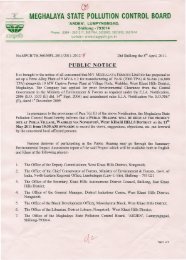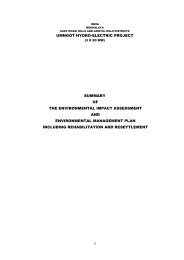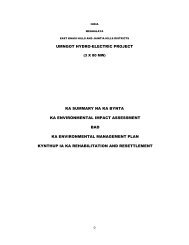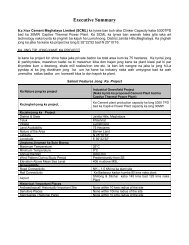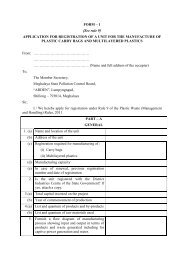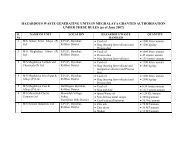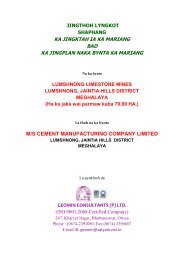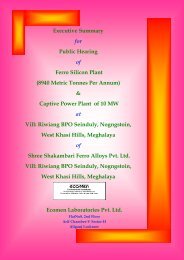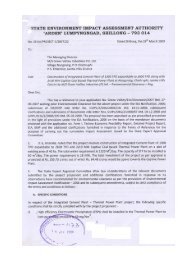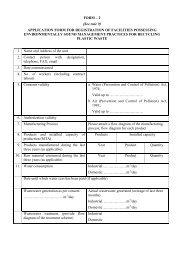chapter - 1 introduction - Meghalaya State Pollution Control Board
chapter - 1 introduction - Meghalaya State Pollution Control Board
chapter - 1 introduction - Meghalaya State Pollution Control Board
Create successful ePaper yourself
Turn your PDF publications into a flip-book with our unique Google optimized e-Paper software.
Hills Cement Co. Limited.<br />
Capacity and Type of Main Storages<br />
SL NO Material<br />
Capacity Tons Type<br />
01 Crushed<br />
Limestone<br />
3x12,000 Rectangular in-line<br />
pre-blending stockpile<br />
02 Clay 7,600 Storage Yard<br />
03 Sand stone 4,700 Storage Yard<br />
04 Gypsum 3,000 Covered Storage<br />
05 Calcined Clay 1,500 Covered Storage<br />
06 Clinker 23,500 RCC Silo<br />
07 Cement 18,000 Stock Pile<br />
08 Coal 7,000 Covered Storage<br />
2. Dry grinding processing<br />
The materials are ground into a flow able powder in horizontal ball mills or<br />
in vertical roller mills. Utilizing waste heat from the kiln exhaust, clinker<br />
cooler hood, or auxiliary heat from a standalone air heater before<br />
pyroprocessing may further dry the raw materials. The moisture content in<br />
the kiln feed of the dry kiln is typically around 0.5% (0 - 0.7%). In a dry<br />
rotary kiln, feed material with much lower moisture content (0.5%) is<br />
used, thereby reducing the need for evaporation and reducing kiln length.<br />
3. Clinker Production<br />
Clinker production is the most energy-intensive stage in cement<br />
production, accounting for over 90% of total industry energy use, and<br />
virtually all of the fuel use. Clinker is produced by pyroprocessing in large<br />
kilns. While many different fuels can be used in the kiln, coal has been<br />
used as the primary fuel.<br />
Alkali or kiln dust (KD) bypass systems may be required in kilns to<br />
remove alkalis, sulfates, and/or chlorides. Such systems lead to additional<br />
energy losses since sensible heat is removed with the bypass gas and<br />
dust. Once the clinker is formed in the rotary kiln, it is cooled rapidly to<br />
minimize the formation of a glass phase and ensure the maximum yield.<br />
The main cooling technologies are either the grate cooler or the tube or<br />
planetary cooler. In the grate cooler, the clinker is transported over a<br />
reciprocating grate. Air flows perpendicular to the flow of clinker.<br />
<strong>Pollution</strong> <strong>Control</strong> Consultants (India) Pvt. Ltd. 19



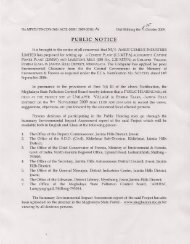
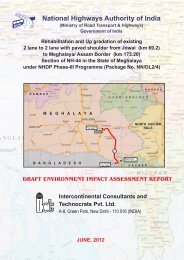

![[FORM I] - Meghalaya State Pollution Control Board](https://img.yumpu.com/49771786/1/190x245/form-i-meghalaya-state-pollution-control-board.jpg?quality=85)

